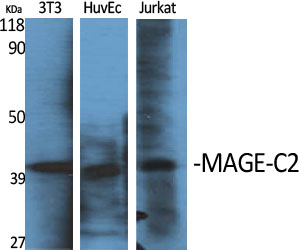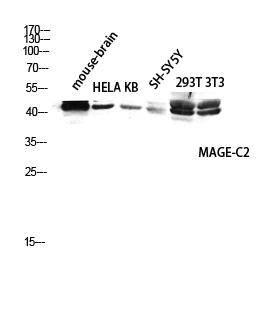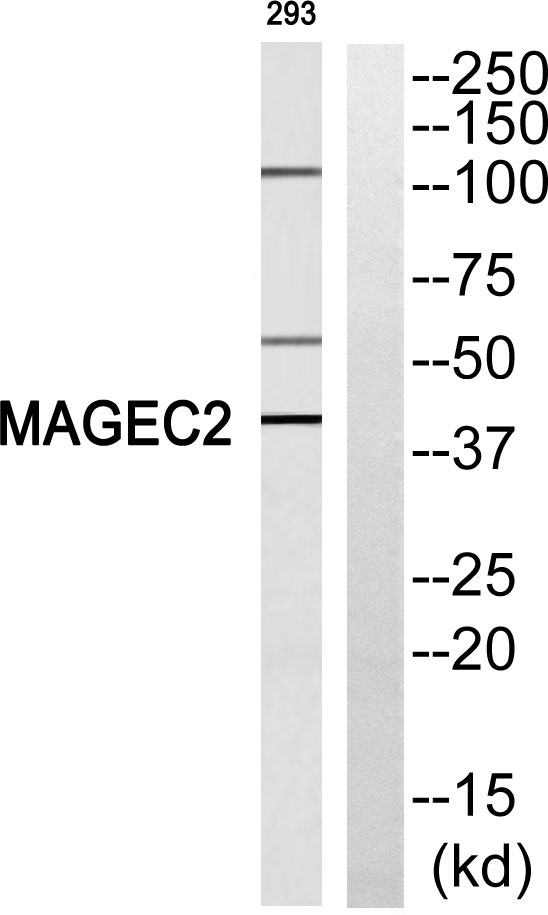MAGE-C2 Polyclonal Antibody
- Catalog No.:YT2626
- Applications:WB;ELISA
- Reactivity:Human;Rat;Mouse;
- Target:
- MAGE-C2
- Gene Name:
- MAGEC2
- Protein Name:
- Melanoma-associated antigen C2
- Human Gene Id:
- 51438
- Human Swiss Prot No:
- Q9UBF1
- Immunogen:
- Synthesized peptide derived from MAGE-C2 . at AA range: 160-240
- Specificity:
- MAGE-C2 Polyclonal Antibody detects endogenous levels of MAGE-C2 protein.
- Formulation:
- Liquid in PBS containing 50% glycerol, 0.5% BSA and 0.02% sodium azide.
- Source:
- Polyclonal, Rabbit,IgG
- Dilution:
- WB 1:500 - 1:2000. ELISA: 1:5000. Not yet tested in other applications.
- Purification:
- The antibody was affinity-purified from rabbit antiserum by affinity-chromatography using epitope-specific immunogen.
- Concentration:
- 1 mg/ml
- Storage Stability:
- -15°C to -25°C/1 year(Do not lower than -25°C)
- Other Name:
- MAGEC2;HCA587;MAGEE1;Melanoma-associated antigen C2;Cancer/testis antigen 10;CT10;Hepatocellular carcinoma-associated antigen 587;MAGE-C2 antigen;MAGE-E1 antigen
- Observed Band(KD):
- 41kD
- Background:
- This gene is a member of the MAGEC gene family. It is not expressed in normal tissues, except for testis, and is expressed in tumors of various histological types. This gene and the other MAGEC genes are clustered on chromosome Xq26-q27. [provided by RefSeq, Oct 2009],
- Function:
- developmental stage:Strongly expressed in spermatogonia and primary spermatocytes. At later stages of maturation, expression gradually decreases and becomes undetectable in mature spermatids.,similarity:Contains 1 MAGE domain.,subcellular location:Nuclear in germ cells. Cytoplasmic in well-differentiated hepatocellular carcinoma, nuclear in moderately- and poorly-differentiated hepatocellular carcinoma.,tissue specificity:Not expressed in normal tissues, except in germ cells in the seminiferous tubules and in Purkinje cells of the cerebellum. Expressed in various tumors, including melanoma, lymphoma, as well as pancreatic cancer, mammary gland cancer, non-small cell lung cancer and liver cancer. In hepatocellular carcinoma, there is a inverse correlation between tumor differentiation and protein expression, i.e. the lower the differentiation, the higher percentage of expression.,
- Subcellular Location:
- Cytoplasm . Nucleus . Nuclear in germ cells. Cytoplasmic in well-differentiated hepatocellular carcinoma, nuclear in moderately- and poorly-differentiated hepatocellular carcinoma.
- Expression:
- Not expressed in normal tissues, except in germ cells in the seminiferous tubules and in Purkinje cells of the cerebellum. Expressed in various tumors, including melanoma, lymphoma, as well as pancreatic cancer, mammary gland cancer, non-small cell lung cancer and liver cancer. In hepatocellular carcinoma, there is an inverse correlation between tumor differentiation and protein expression, i.e. the lower the differentiation, the higher percentage of expression.
- June 19-2018
- WESTERN IMMUNOBLOTTING PROTOCOL
- June 19-2018
- IMMUNOHISTOCHEMISTRY-PARAFFIN PROTOCOL
- June 19-2018
- IMMUNOFLUORESCENCE PROTOCOL
- September 08-2020
- FLOW-CYTOMEYRT-PROTOCOL
- May 20-2022
- Cell-Based ELISA│解您多样本WB检测之困扰
- July 13-2018
- CELL-BASED-ELISA-PROTOCOL-FOR-ACETYL-PROTEIN
- July 13-2018
- CELL-BASED-ELISA-PROTOCOL-FOR-PHOSPHO-PROTEIN
- July 13-2018
- Antibody-FAQs
- Products Images

- Western Blot analysis of various cells using MAGE-C2 Polyclonal Antibody diluted at 1:1000
.jpg)
- Western Blot analysis of 293 cells using MAGE-C2 Polyclonal Antibody diluted at 1:1000

- Western blot analysis of mouse-brain HELA KB SH-SY5Y 293T 3T3 lysis using MAGE-C2 antibody. Antibody was diluted at 1:1000

- Western blot analysis of MAGEC2 Antibody. The lane on the right is blocked with the MAGEC2 peptide.



